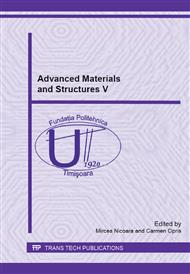p.243
p.249
p.255
p.261
p.267
p.273
p.279
p.283
p.288
Research on Increasing the Nitrogen Removal Efficiency by Changing the Secondary Treatment Parameters
Abstract:
The existence of gases in the solid metals (hydrogen and nitrogen) assumes the presence of these gases in metals even before solidification, respectively in the elaboration, secondary treatment and casting phases. Usually, great amounts of gases dissolved in steels can be detected, between 3.5-8ppm for hydrogen and 0.02-0.03% for nitrogen, respectively. There are also cases when the purpose is to alloy with nitrogen, this being the case of austenitic stainless steels where the nitrogen content can reach 0.5% using ferrochromium or ferromanganese alloyed with nitrogen in 3-5.5 %. The main method of removing these gases is bubbling with inert gases and /or treating the steel in a vacuum facility. The paper presents a study regarding increasing the removal efficiency of nitrogen from the liquid steel by changing the bubbling parameters (flow, pressure, duration) but also the basicity of the refining slag. The equations of the regression surface and the identified fields are of a real help for the technologists, allowing quick decisions but they are also important for the quality of the metallic products [.
Info:
Periodical:
Pages:
267-272
Citation:
Online since:
August 2014
Authors:
Keywords:
Price:
Сopyright:
© 2014 Trans Tech Publications Ltd. All Rights Reserved
Share:
Citation:


